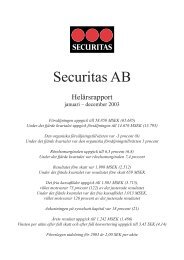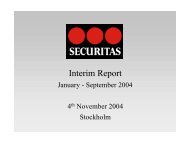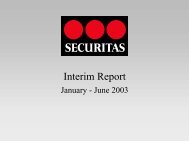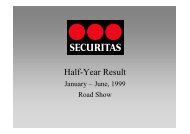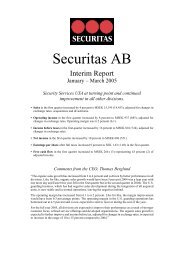Annual Report 2008 - Securitas
Annual Report 2008 - Securitas
Annual Report 2008 - Securitas
You also want an ePaper? Increase the reach of your titles
YUMPU automatically turns print PDFs into web optimized ePapers that Google loves.
78 <strong>Annual</strong> report<br />
Notes and comments to the consolidated financial statements<br />
Note 4. Critical estimates and judgments<br />
and items affecting comparability<br />
The preparation of financial reports requires the Board of Directors and Group<br />
Management to make estimates and judgments using certain assumptions.<br />
Estimates and judgments will impact both the statement of income and the<br />
balance sheet as well as disclosures such as contingent liabilities. Actual<br />
results may differ from these estimates and judgments under different<br />
assumptions and conditions.<br />
Valuation of identifiable assets and liabilities in<br />
connection with the acquisition of subsidiaries/operations<br />
The valuation of identifiable assets and liabilities in connection with the acquisition<br />
of subsidiaries or operations as part of the purchase price allocation<br />
involves that items in the acquired company’s balance sheet as well as items<br />
that have not been recognized in the acquired company’s balance sheet<br />
such as customer relations should be valued at fair value. In normal circumstances,<br />
as quoted market prices are not available for the assets and liabilities<br />
that are to be valued, different valuation methods have to be used. These<br />
valuation methods are based on a number of assumptions. Other items that<br />
can be difficult both to identify as well as to value are contingent liabilities<br />
that could have arisen in the acquired company such as litigation related<br />
items. All balance sheet items are thus subject to estimates and judgments.<br />
Further information is provided in Note 16.<br />
Impairment testing of goodwill and<br />
other acquisition related intangible assets<br />
In connection with the impairment testing of goodwill and other acquisition<br />
related intangible assets, the book value is compared with the recoverable<br />
value. The recoverable value is determined by the higher of an asset’s net<br />
realizable value and its value in use. Since under normal circumstances no<br />
quoted market prices are available to assess an asset’s net realizable value,<br />
the book value is normally compared with the value in use. The calculation<br />
of the value in use is based on assumptions and judgments. The most important<br />
assumptions are the organic sales growth, the development of the<br />
operating margin, the operating working capital requirements and the relevant<br />
WACC, which is used to discount future cash flows. All in all, this means<br />
that the valuation of the balance sheet items Goodwill, which amounts to<br />
MSEK 14,104.3 (13,793.5 and 14,031.6) and Acquisition related intangible<br />
assets, which amounts to MSEK 751.3 (624.0 and 464.2), are subject to<br />
critical estimates and judgments. A sensitivity analysis regarding the organic<br />
sales growth, the operating margin and the wAcc is provided in Note 16.<br />
Valuation of accounts receivable<br />
and the provision for bad debt losses<br />
Accounts receivable, which amounts to MSEK 9,962.6 (9,889.4 and<br />
8,855.6), is one of the most significant balance sheet items. Accounts<br />
receivable are accounted net after provisions for probable bad debt. The<br />
provision for bad debt losses, which amounts to MSEK –354.4 (–324.3 and<br />
–297.0), is thus subject to critical estimates and judgments. Further information<br />
regarding the credit risk in accounts receivable is provided in Note 6.<br />
Information regarding the development of the provision for bad debt losses<br />
during the year is provided in Note 25.<br />
Actuarial calculations regarding employee benefits<br />
such as pensions and medical benefits<br />
Employee benefits are normally an area where estimates and judgments are<br />
not critical. However for defined benefit plans relating to benefits particularly<br />
for pensions and medical benefits and where the payment to the<br />
employee is several years into the future, actuarial calculations are required.<br />
These calculations are based on assumptions regarding economic variables<br />
such as the discount rate, the expected return on plan assets, salary increases,<br />
inflation rate, pension increases and the inflation rate for medical<br />
benefits, but also on demographic variables such as the expected life span.<br />
<strong>Securitas</strong> <strong>Annual</strong> report <strong>2008</strong><br />
All in all, the balance sheet item pension balances for defined benefit plans,<br />
which amounts to MSEK 8.4 (17.9 and 7.0) and which is stated under other<br />
long-term receivables, and the balance sheet item provisions for pensions<br />
and similar commitments, which amounts to MSEK 1,250.1 (946.1 and<br />
1,055.9), are subject to critical estimates and judgments. The Group’s<br />
opinion is that the most important assumptions are the discount rate, the<br />
inflation rate and the expected life span. A sensitivity analysis regarding<br />
these three variables is provided in Note 32.<br />
Actuarial calculations regarding claims reserves<br />
The Group is exposed to various types of risks in the day-to-day running of<br />
the business. The operational risks can result in the need to recognize reserves<br />
for damages resulting from property claims, personal injuries as well as<br />
workers’ compensation claims relating to the Group’s employees. claims<br />
reserves are calculated based on a combination of case reserves and incurred<br />
but not reported reserves. Actuarial calculations are performed on a quarterly<br />
basis to assess the adequacy of the reserves based on open claims and<br />
historical data for incurred but not reported claims. Actuarial calculations are<br />
based on several assumptions. All in all, this means that the balance sheet<br />
items short-term Liability insurance-related claims reserves, which amounts<br />
to MSEK 652.5 (694.6 and 819.0) and is included in Other short-term<br />
provisions (Note 36) and Liability insurance-related claims reserves, which<br />
amounts to MSEK 603.3 (724.3 and 595.7) and is included in Other provisions<br />
(Note 33), are subject to critical estimates and judgments.<br />
The impact on the Group’s financial position of ongoing<br />
litigation and the valuation of contingent liabilities<br />
Over the years the Group has made a number of acquisitions in different<br />
countries. As a result of such acquisitions certain contingent liabilities of the<br />
businesses acquired have been assumed. companies within the Group are<br />
also involved in a number of other legal proceedings and tax audits arising<br />
out of the operations. Further information is provided in Note 38.<br />
Items affecting comparability<br />
Items affecting comparability amounted to MSEK –29.3 (–78.1 and –549.1).<br />
The items affecting comparability that are described below constitute<br />
the most material individual transactions that demand that the management<br />
make judgments that can be deemed reasonable under the prevailing<br />
circumstances, taking into consideration the information that is available on<br />
the balance sheet date. The items that involve the largest elements of<br />
judgement are:<br />
USA – Globe/Federal Aviation Admininstration<br />
Prior to the Aviation and Transportation Security Act (Aviation Security Act),<br />
which was passed in November 2001, the air carriers were responsible<br />
under federal law for providing pre-board screening of passengers. In most<br />
cases, the air carriers contracted with private security companies for these<br />
services. Under the Aviation Security Act, pre-board screening services<br />
were federalized in two steps. The first step consisted of a transition period<br />
where the Federal Aviation Administration (FAA) became the party responsible<br />
for pre-board screening and contracted with private security<br />
companies for these services (the FAA’s responsibilities were later transitioned<br />
to the Transportation Security Administration (TSA)). The second step,<br />
which occurred in November 2002, consisted of the TSA directly providing<br />
these services by federal government employees. Globe had been requested<br />
to provide pre-board screening services during the initial transition<br />
period and, following extended negotiations, Globe entered into an agreement<br />
with the FAA in February 2002 to provide such services during the<br />
transition period. Based on the performance of Globe during this transition<br />
period, in April 2002 Globe contracted with the FAA/TSA to service additional<br />
airports. During the transition period, the FAA/TSA compensated Globe<br />
based on the governing contract and the invoices submitted.




